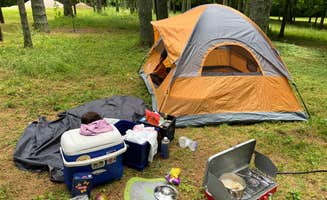Primitive camping near Williamstown, West Virginia centers primarily on Wayne National Forest across the Ohio River. Wayne Forest spans over 241,000 acres with numerous dispersed camping areas accessible via Forest Service roads. Weather conditions significantly affect access, with spring thaws often creating challenging mud conditions through June, and fall bringing optimal hiking temperatures but increased competition for sites.
What to do
Hiking through varied terrain: Witch's Peak offers a challenging but rewarding hike with significant elevation gain. "The trail in is super steep. The climb is totally worth it though. Some amazing rock out croppings and views up there! There are several boulder routes as well," notes Lucille W., who also mentions the rock shelter at the trail's end.
Trail loops for different abilities: Wildcat Hollow Hiking Trail Dispersed features both short and extended options. "There is a 5 mile loop or a longer ~15 mile loop that you can hike and there are campsites every couple of miles," according to Steve C., making it adaptable for different skill levels and trip durations.
Spring wildflower viewing: The forest floor transforms seasonally with native wildflowers. "I recommend visiting Wildcat hollow in the springtime as the forest floor will be carpeted with beautiful wildflowers," suggests Lucille W., highlighting early May as peak viewing time for ephemeral blooms.
What campers like
Solitude and tranquility: The remote settings appeal to those seeking quiet. "Overall, it was a beautiful, quiet place and I only saw 2 other people in the trail while I was hiking out the second day," reports Steve C. about his Wildcat Hollow experience. Weekday visitors particularly note the peaceful atmosphere.
Camping flexibility: Monday Creek OHV Dispersed receives praise for its straightforward setup. "Camped at the west side of the vaulted toilet lot. Arrived about 5 PM and all 3 camping spots were empty," notes Kevin C., highlighting the last-minute availability even during busy periods.
Primitive experience: The basic amenities appeal to wilderness enthusiasts. "The sites themselves are just semi-cleared areas with stone fire rings so it is totally primitive camping," explains Steve C. about Wildcat Hollow, capturing the minimalist appeal that draws backcountry campers to this region.
What you should know
Limited water sources: Streams exist but often aren't suitable for treatment. "While there is water in the valleys I wouldn't use it even with a filter. There are signs posted at the trailhead that advise against it plus there is still active oil drilling in one of the hollows," warns Steve C. about Wildcat Hollow Hiking Trail.
Variable cellular reception: Connectivity fluctuates with terrain. "There is cell service when you're up in the ridges but there are a lot of dead zones in the valleys and even at the trailhead," notes Steve C., making ridge camping preferable for those needing to maintain communications.
Seasonal facility closures: Winter brings limitations to amenities. "Pit toilet closed for winter. Most campsites inaccessible during off-season," reports Doug H. about Dorr-Run Red Oak Trailhead, indicating the need for self-sufficiency during colder months.
Tips for camping with families
Consider trailhead camping: For families with young children, Dorr-Run Red Oak Trailhead offers accessible options. "There are plenty of pull-off areas on the road leading up to this trailhead that were being used night one as well. There were restrooms and several fire rings," explains Taylor P., providing easier access than deep backcountry sites.
Plan for variable weekend crowds: Family groups should arrive early on weekends. "Saturday was super busy, and we snagged the last available spot with a fire ring. The second night we only had one tent near us," reports Taylor P., highlighting the dramatic difference in occupancy between weekend and weekday nights.
Choose beginner-friendly backpacking: Wildcat Hollow suits first-time family backpackers. "Perfect place for a first time backpacking trek," suggests Lucille W., though families should still prepare for challenging trail sections, especially after rain.
Tips from RVers
Small RV options only: Kinderhook Horse Trail accommodates compact vehicles but not large rigs. "Nice clean area just off main road. Can camp here in certain spots. Not much area to camp. Definitely only for very small camper, car camp, or tent, small group," explains Joe B., emphasizing the size limitations.
Overnight stopover potential: The basic facilities make convenient travel breaks. "Just wanted an overnight spot to clear our heads and enjoy the outdoors. Parked our RRT in the parking lot on a Monday evening and had the place pretty much all to ourselves all night," notes Chris B. about his experience at a trailhead parking area.
Off-season advantages: Winter camping offers solitude for properly equipped RVers. "Most campsites inaccessible during off-season," reports Doug H., but notes the benefit as "Nice place" for those with vehicles capable of navigating seasonal conditions.



